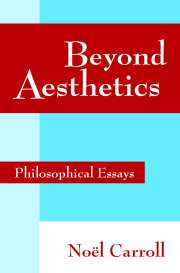Book contents
- Frontmatter
- Contents
- Foreword by Peter Kivy
- Introduction
- PART I BEYOND AESTHETICS
- PART II ART, HISTORY, AND NARRATIVE
- PART III INTERPRETATION AND INTENTION
- PART IV ART, EMOTION, AND MORTALITY
- Art, Narrative, and Emotion
- Horror and Humor
- The Paradox of Suspense
- Art, Narrative, and Moral Understanding
- Moderate Moralism
- Simulation, Emotions, and Morality
- PART V ALTERNATIVE TOPICS
- Notes
- Index
Art, Narrative, and Moral Understanding
Published online by Cambridge University Press: 19 January 2010
- Frontmatter
- Contents
- Foreword by Peter Kivy
- Introduction
- PART I BEYOND AESTHETICS
- PART II ART, HISTORY, AND NARRATIVE
- PART III INTERPRETATION AND INTENTION
- PART IV ART, EMOTION, AND MORTALITY
- Art, Narrative, and Emotion
- Horror and Humor
- The Paradox of Suspense
- Art, Narrative, and Moral Understanding
- Moderate Moralism
- Simulation, Emotions, and Morality
- PART V ALTERNATIVE TOPICS
- Notes
- Index
Summary
With much art, we are naturally inclined to speak of it in moral terms. Especially when considering things like novels, short stories, epic poems, plays, and movies, we seem to fall effortlessly into talking about them in terms of ethical significance – in terms of whether or which characters are virtuous or vicious, and about whether the work itself is moral or immoral, and perhaps whether it is sexist or racist. Undoubtedly, poststructuralists will choke on my use of the phrase “naturally inclined,” just because they do not believe that humans are naturally inclined toward anything. But that general premise is as needlessly strong a presupposition as it is patently false. And, furthermore, I hope to show that my talk of natural inclinations is hardly misplaced here, for we are prone to respond to the types of works in question in the language of moral assessment exactly because of the kinds of things they are.
Moreover, we do not merely make moral assessments of artworks as a whole and characters in particular; it is also the case that these moral assessments are variable. That is, we find some artworks to be morally good, while some others are not; some are exemplary, while some others are vicious and perhaps even pernicious; and finally other works may not appear to call for either moral approbation or opprobrium. So, though we very frequently do advance moral assessments of artworks, it is important to stress that we have a gamut of possible evaluative judgments at our disposal: from the morally good to the bad to the ugly, to the morally indifferent and the irrelevant.
- Type
- Chapter
- Information
- Beyond AestheticsPhilosophical Essays, pp. 270 - 293Publisher: Cambridge University PressPrint publication year: 2001
- 2
- Cited by



